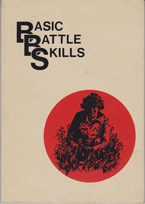Basic Battle Skills
Basic Battle Skills are the fundamental techniques and knowledge required for effective participation in combat situations. These skills are essential for soldiers, law enforcement personnel, and individuals involved in martial arts or self-defense. Basic Battle Skills encompass a wide range of abilities, from physical conditioning and weapon handling to tactical thinking and teamwork.
Overview[edit | edit source]
Basic Battle Skills form the foundation upon which more advanced combat techniques and strategies are built. They are typically taught in military training programs, police academies, and martial arts schools. The mastery of these skills is crucial for survival and success in hostile environments.
Physical Conditioning[edit | edit source]
Physical conditioning is at the core of Basic Battle Skills. It includes strength training, endurance exercises, and flexibility routines. A well-conditioned body can endure the rigors of combat, perform a variety of physical tasks, and recover more quickly from injuries.
- Strength Training: Focuses on building muscle power and endurance, enabling soldiers to carry heavy equipment, maneuver in difficult terrains, and overpower opponents.
- Endurance Exercises: Improve cardiovascular health, allowing for sustained physical activity over long periods.
- Flexibility Routines: Enhance the range of motion, reducing the risk of injuries and improving combat maneuverability.
Weapon Handling[edit | edit source]
Proficiency in weapon handling is another critical aspect of Basic Battle Skills. This includes the safe operation, maintenance, and effective use of firearms, edged weapons, and other combat tools.
- Firearms Training: Covers the basics of shooting, aiming, reloading, and clearing malfunctions.
- Edged Weapons: Involves training with knives, bayonets, and swords, focusing on striking, blocking, and disarming techniques.
- Maintenance: Teaches the proper care and upkeep of weapons to ensure reliability in the field.
Tactical Skills[edit | edit source]
Tactical skills involve the application of strategies and maneuvers to gain an advantage over the enemy. This includes understanding terrain, using cover and concealment, and coordinating movements with a team.
- Terrain Navigation: Involves reading maps, using compasses, and recognizing natural features to navigate through unfamiliar environments.
- Cover and Concealment: Teaches how to use the environment to hide from enemy observation and protect oneself from enemy fire.
- Team Coordination: Focuses on communication and teamwork to execute complex maneuvers and strategies effectively.
Survival Skills[edit | edit source]
Survival skills are essential for enduring adverse conditions and sustaining life in combat zones. These skills include finding food and water, first aid, and shelter construction.
- Foraging: Identifies edible plants and methods for trapping or hunting small game.
- First Aid: Covers basic life-saving techniques, including CPR, wound care, and the treatment of common injuries.
- Shelter: Teaches how to construct temporary shelters using natural or improvised materials.
Conclusion[edit | edit source]
Basic Battle Skills are the bedrock of combat readiness, providing individuals with the tools they need to survive and thrive in hostile situations. Continuous training and practice are essential for maintaining these skills at a high level of proficiency.
| Basic Battle Skills Resources | ||
|---|---|---|
|
| |
Translate to: East Asian
中文,
日本,
한국어,
South Asian
हिन्दी,
Urdu,
বাংলা,
తెలుగు,
தமிழ்,
ಕನ್ನಡ,
Southeast Asian
Indonesian,
Vietnamese,
Thai,
မြန်မာဘာသာ,
European
español,
Deutsch,
français,
русский,
português do Brasil,
Italian,
polski
Navigation: Wellness - Encyclopedia - Health topics - Disease Index - Drugs - World Directory - Gray's Anatomy - Keto diet - Recipes
Search WikiMD
Ad.Tired of being Overweight? Try W8MD's physician weight loss program.
Semaglutide (Ozempic / Wegovy and Tirzepatide (Mounjaro / Zepbound) available.
Advertise on WikiMD
WikiMD is not a substitute for professional medical advice. See full disclaimer.
Credits:Most images are courtesy of Wikimedia commons, and templates Wikipedia, licensed under CC BY SA or similar.Contributors: Prab R. Tumpati, MD


